The available fishing electronics are several steps ahead in development compared to a few decades ago. One field that is incredibly hard to maintain, even for a techno-junkie like me, would be the technological advancement field. Echo sounding, imagery, and satellite navigation have made the fishers close to what is happening beneath the water’s surface. But a decade was spent in the retail business selling kayak fish finder, which imparted essential qualities.
First, many fishermen experience some difficulties defining all the existing fishing electronics options. Secondly, most fishers subscribe to functions they don’t require and have zero utility for. For the first-timer who wants to install a kayak fish finder or those planning to upgrade- here is a small flying Phoenix guide to the potential attributes.
What is a Fish Finder?
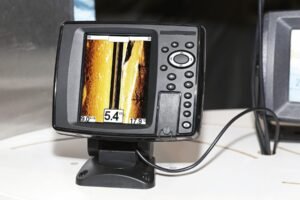
Kayak Fish finders are good only for locating the spots beneath the water’s surface, just like any other tool that provides important aspects about the water you are fishing in so you can better decide how to fish. That, in turn, enables you to capture more fish from the sea, lake, etc., or whatever body of water you have chosen.
At their core, all kayak fish finders have two things: a transducer and a head unit. A transducer is a device that translates sound signals into electrical signals, while a head unit is a component of an audio system that amplifies these signals. The transducer transmits sound down through the water; the sound waves reflect to the boat after it’s hit things such as the bottom, weeds, logs, and of course, fish.
It takes time for those signals to bounce back when the object is far off than for an object close to the boat. In their turn, those sonar signals are under consideration and compiled into one rather comprehensible heading by the head unit.
Kayak Fish finders these days have so many modern additions you can add on as many files as your pocket is deep to tell you so many other things many fishers find beneficial.
Paying more for a Kayak fish finder with GPS, for example, lets you mark particular hot spots for fish and display your trolling speed so you can find the best bite much quicker without fumbling around and reinventing the wheel each time you head out.
1. Lowrance Hook2 4X
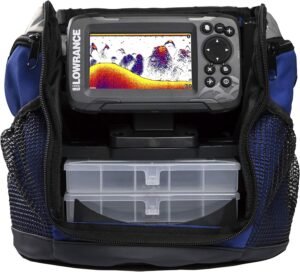
Featuring a balance between a color display, DB sonar, navigation, portability, and affordability, the Lowrance Hook2 4x is the best portable kayak fish finder for diverse consumer categories and one of the best kayak fish finders by Lowrance. This type of transducer is a wide-angle transducer that produces luminous and clear picture representations of structures and fishes.
For the navigation aspect in the Hook2 4x, a GPS plotter lets one set waypoints for a course and track progress. The Lowrance kayak fish finder and GPS is a portable and compact model with the added advantage of featuring a carry case that has space for tackle trays and a battery. Thankfully, this Lowrance kayak fish finder is of good value, and they make really good models at a wide range of price levels.
Specs
- Weight: 4.5 pounds
- Dimensions: 18” x 10” x 6”
- Screen Size: 4 inches
2. Garmin Echomap UHD 7 Panoptix PS22 Bundle
![Garmin ECHOMAP UHD2 73CV Chartplotter/Fishfinder with US Inland Maps and GT20-TM [010-02594-51]](https://kayakaddiction.com/wp-content/uploads/2024/06/61vM9UdqcL._AC_SL1000_-270x300.jpg)
Outfitted with the live view sonar, chart, and Panoptix PS22, the Garmin Echomap UHD 7 disentangles the complexities of fishing with an impressive performance that pits it as one of the best Garmin fish finders. It is a convenient control feature as the screen is seven inches plus and easy to operate for a portable device.CHIRP sonar sends signals at two frequencies to produce a detailed image of the fish and its structure.
Shoot the image with LiveVu Forward or LiveVu Down to perform a real-time video, like a live picture capture of fish up to a distance of 100 feet from where the picture was captured.
The Echomap 7 UHD comes with Garmin’s lake cartography of the LakeVu service and Navionics navigation to target such productive water. Features like Bluetooth and WiFi lets you get data on navigation and change the charts with the help of a smartphone.
The Garmin is also the company’s most advanced kayak fish finder and GPS and is conveniently contained in a soft-sided carry case, which includes the transducer, batteries, and display. The package comes with a swivel pole for a LiveVu transducer to place it under ice together with a standard transducer for CHIRP sonar. The Garmin UHD 7 Panoptix bundle lets you bring one of the most powerful kayak fish finder solutions anywhere you go for all your fishing adventures.
Specs
- Weight: 16.7 pounds
- Dimensions: 12.3” x 14.5” x 10”
- Screen Size: 7 inches
3. Humminbird Helix 5 CHIRP GPS G3 PT
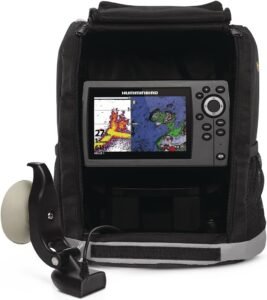
As you would expect, Humminbird fish finders have great value, and the exact model referenced is the Helix 5 dual-spectrum CHIRP. It is designed for ice fishing and has the battery installed right out of the box. However, conversions to a Jon boat- or kayak-like forage will be quite easy, with very few modifications required for this unit. However, one significant difference is that the Helix 5 allows you to fish without purchasing additional base maps. However, unlike other portable drives, it can be upgraded with the help of SD card updates from the company.
Thus, an unrecognized or hidden function of the Helix units of Humminbird is the auto-chart feature. If they fish on other less famous small lakes without maps, it makes it quite different or unique. As you navigate through the feature, it switches on, and the unit traces the disposition of the bottom of the lake. It benefits the occasional fishermen who fish a limited number of lakes and do not require a costly card with those lakes they will never navigate through.
I also like how all The buttons and the navigation on Humminbird are in order. For instance, although I have become familiar with the Helix 9, I realize that the version of Helix 5 used here has almost the same menus and settings as those found in the former. One of the most admirable features that especially applies to stability is the ability to change the settings of the water quickly.
The only true area where this unit does not offer tremendous value is that it cannot be networked with Humminbird’s side, down, 360, or Mega Live Imaging capabilities. However, the 2D CHIRP sonar is more than adequate for most fishing purposes because of its efficient function throughout the intended fishing depth ranges. They are not expensive; Humminbird sells this combo at less than $500, which includes a battery and carrying case. We like this unit for those target species or beginners who want to experience technology and need versatility. The Helix 5 is a great system that’s complex, logical, and dependable; you won’t be spending an arm and a leg.
Specs
- Weight: 12.5 pounds
- Dimensions: 755” x 4.28” x 1.13”
- Screen Size: 5 inches
4. Garmin Striker 4 Portable Bundle
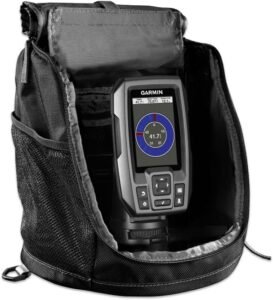
Low-profile portable units that are lightweight: No ‘Low profile portable’ fish finder can match Garmin Striker 4. Consequently, this is an easy unit that can quickly be changed between an ice unit and a kayak unit as it is airy and occupies little space.
It will comfortably fit most fishing kayaks by incorporating a rail accessory, as in the image. The narrow screen also means that it has less tendency to become off-balanced on the rail compared to a gadget with a wide screen. As is typical with many more compact units, it comes equipped with a basic CHIRP transducer that provides clear and sharp images.
It is perhaps just a question of taste. Still, I found the Garmin’s CHIRP clearer looking than the Echomax, mainly because it is a little easier to paint a fish-shaped target or outline against other interferences that may be displayed in the water column.
Although this unit has the GP, it only serves as a reference location for the fish and other structures of interest found along the trip. The pattern of this unit does not contain contours of the underwater.
Far from a deal maker or breaker, it suggests that the angler may have to do more work to find the hot area where to cast the reel. We are okay with that because the unit includes a decent built-in flasher for the conserved ones. Originally, it is designed for ice fishing, but nothing can prevent you from using it for vertical fishing when you are in a boat.
The Striker 4 is also often available at a discount, causing it to be often cheaper than the $200 suggested retail price. We also like simple things such as replacing the transducer with the company’s own GT8 or GT15 for somewhat more sensitivity. This unit can be expanded as the angler progresses a little in using electronics in his fishing endeavours.
Specs
- Weight: 12.5 pounds
- Dimensions: 755” x 4.28” x 1.13”
- Screen Size: 5 inches
5. HawkEye FishTrax 1C-K Paddlesport
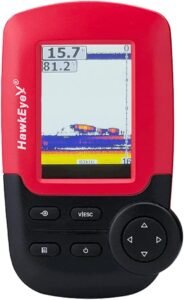
Overall, knowing the essentials about kayak fish finders and considering the given specifications, this kayak fish finder is suitable for use with a kayak. The FishTrax 1C-K Paddlesport only weighs 300 grams, and it has the smallest and the least heavy glare-resistant colour display among all the kayak fish finders in my review.
The display and the transducer are mounted on the base, which can clamp onto any standard gear track, thus, requiring little or no time to attach, and detaching is just as quick. As noted, the universal transducer is good to have on a boat or kayak, and it floats for ice fishing.
However, with the ice fishing bag and other accessories, HawkEye provides the FishTrax 1c-K with more tools to accommodate more than just the kayak kit. Or, use your own accessories; adjustable foot side’s TraxNut screws into any ¼ – 20 threaded mount.
To top it all off, the unit operates for 30 hours on four easily accessible AAA batteries beneath a rear panel flap, thereby eliminating the need for an exterior battery pack and cables. I think it perfectly suits kayak fishing needs, and thus, it’s undoubtedly one of the best out there.
Specs
- Weight: 3 pounds
- Dimensions: 10” x 9” x 5”
- Screen Size: 2 inches
6. Lucky Kayak Handheld Kayak Fish Finder
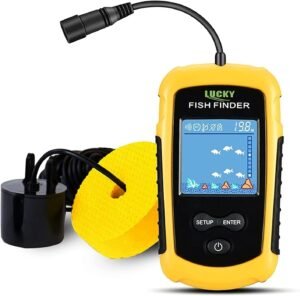
I was very interested in using a kayak fish finder from the shore since it is unique in some ways. However, a castable transducer works in the Lucky kayak handheld, which relays underwater information of up to 300ft. Unlike other castable transducers, it has its own dedicated display, not just a couple of digits on the main one. Modern kayak fish finders can be described as having diverse characteristics and being very sophisticated.
This one is for everyone in a hurry, and all they need is an answer to their question without reading through long text. Interestingly, all the fundamentals concerning the depth and location of fishes are found here. The figure depicts three varieties of fish icons to point to the size of every target, large, medium, and small.
The finder also displays the existing water temperature, meaning an angler can crank up the lure depending on the water temperature. Nevertheless, it is capable of displaying the ‘bottom’ and the ‘structure’ as well. This finder is handy when hunting for ice fishing or other small boats like kayaks.
The only major complaint is that the manufacturer has been known to give it a Waterproof label most of the time. As long as you handle it like any other electronics around the shoreline, it will be long-lasting. I like it for a young man who is new to fishing or a first-time fisherman.
Specs
- Weight: 11.6 ounces
- Dimensions: 6.46″ x 4.65″ x 4.02″
- Screen Size: 4 inches
7. Humminbird Ice Helix 9 Mega Live
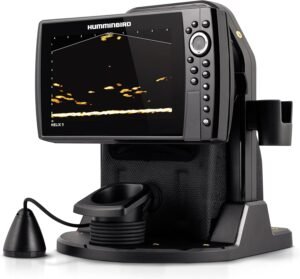
Over the years, they have become fixtures in most kayak fish finder product categories, with Humminbird being a recognized kayak fish finder staple. They developed the best kayak fish finder and GPS that one can bring everywhere with the Ice Helix 9 MEGA. The kayak fish finder uses Humminbird’s newest MEGA Live sonar technology, which gives the best live images of fish and their surroundings up to a distance of 100 feet from the fisherman. The full sonar alternatives are empowered in the Helix 9 through CHIRP, down scan, and side scan imaging.
Angling, particularly through ice fishing, as evidenced in the Humminbird Helix 9 kayak Fish Finder.
Additionally, let me talk about what I have achieved with ice fishing using the Helix 9. (Photo/Travis Smola)
Regarding its navigational functions, the Helix 9 comes with the best Humminbird LakeMaster and CoastMaster charts, detailed depth contours to one foot, and the most up-to-date information on the waterway.
In particular, an excellent kayak fish finder for ice fishing is the Helix 9 seven-paddle device with a large and clear nine-inch screen. Its controls are simple to operate using hands with somewhat of a grasp despite being numb or coated in fish slime. Spending a considerable amount of money on any device can be daunting, but if you find yourself needing a kayak fish finder and ice fishing accessories, the Humminbird fish finder is the appropriate companion for you, or you may want to add a base for the control head and bracket for the transducer to offload the Helix 9 on your boat or kayak.
Specs
- Screen Size: 9 inches
- Power Draw: 2.4 amps
- Maximum Depth: 1,200 feet
8. Deeper Pro+
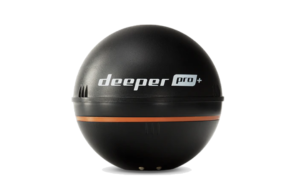
Own a powerful and simple sonar on the smartphone and a rudimentary GPS to get started. Mount the Deeper Pro Plus to its iOS or Android app, fasten the transducer ball to your fishing line, cast it to a 300-foot distance away, and then pull slowly. Through a dual-signal transducer, the unit captures and relays the images of the fish and bottom on your smartphone screen and instantly facilitates depth and water temperature.
With the help of this gadget’s mapping feature on, the Deeper Pro Plus will automatically set its map to the bottom. Furthermore, the GPS plotter provides the simplest form of navigation and route planning while also giving the ability to save a waypoint on the device itself. The two elements I like most are a digital fishing log option that enables us to document our best catches and an online social network to share this experience with friends.
Specs
- Screen Size: 3.53 inches
- Dimensions: 5.9” x 5.32” x 2.95”
- Maximum Depth: 260 feet
9. Humminbird Helix 5 Sonar G2

The first kayak fish finder that I purchased was the Helix 5 Sonar G2, which I continue to fish today aboard my Jackson Mayfly. For those with the Old Town or Ocean Kayak, the installation of the transducer is quite simple since it is merely placed in front, and the cable will run through the scupper. Depending on the kayak, such as the Mayfly, it is possible to rig the mount yourself or use a YakAttack SwitchBlade transducer arm.
The screen’s size, 5 inches, is quite adequate to see the contour and structure details at the bottom and yet does not interfere. Instead of a graphical touch screen, which is quite slow but more likely to malfunction, you will be using the keypad to navigate through the menus and settings.
The build quality and features are quite dated, but that is understandable when you’re shopping for an entry-level kayak fish finder. I use this unit just to check the water depth and hard features like large rocks and look for steep slopes. I do not rely on it to identify things such as variance or to accurately note bait at a fair distance. However, they are sufficient for the majority of fishing processes that do not require any additional functions to perform.
Specs
- Keypad Control
- Transducer: DualBeam PLUS
- Water temp sensor
10. Humminbird Helix 7 CHIRP SI GPS G4
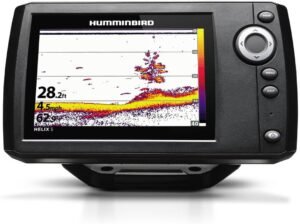
A variety of species include Cod, Haddock, Pollock, Sak eels, Skate, Squid and Tuna that Ric Burnley targets on saltwater close to Virginia Beach. “I did not have a kayak fish finder for many years as they were rather cumbersome, actually,” he remarked. “But kayak fish finders have come a long way. ”
Burnley now fishes in almost all his fishing trips with his Helix 7 on his Ocean Kayak Trident 13. For example, when used for speckled trout fishing, he exclaimed: “I love the side-scan.” “ You can spot schools of speckled trout, find the grass beds, and also the structures; it is nearly a must-have for spring big red drum fishing.”
In this case, Burnley will paddle around using his Helix 7 to look for the big drum on the side imaging looking for schools of bull reds. Side imaging reveals the events in a 125-foot sweep to both sides of the boat, making the use of the equipment an effective way to go over an area fast.
“Finally, he claimed that you should know how one reads the side scan and what specific marks stand for. But when those drums show up on there, it’s very obvious,” he said. Burnley owns other kayak fish finders with side scans, but he thinks the Humminbird’s contrast and detail are the best.
Well, the Helix 7 does not come with detailed charts; however, the ones it comes with are perfect for navigating various waters. The maps could be a little bit better, but you can upgrade them if you need detailed charts.
One thing that Burnley likes to utilize while moving around the underwater region looking for drums is the breadcrumb feature so he can easily identify his coverage area and possibly backtrack to locate the areas where he was last seeing fish. Burnley also said as much as years of activity his Helix 7 waiting for a tournament is still free from issues.
Specs
- Down Imaging and Side Imaging
- 7-inch display
- Keypad Control
- Mapping: Humminbird Basemap
How to Choose a Kayak Fish Finder
There are cheaper versions that can cost a few hundred dollars and the more expensive ones which can cost as much as a few thousand dollars. This means that the type of model that you select for the consistent mode depends on the style of fishing.
If you prefer a certain approach, like vertical jigging for lake trout in huge water where you won’t attempt to make numerous starts, a kayak fish finder is a necessary tool, and you won’t mind spending a few extra bucks on a good one.
However, if you fish mostly on saltwater flats, you do not require a kayak fish finder; any low-end variety will suffice. Apart from the price category, you will have to choose between various transducers and shoe sizes and also consider how you can easily fix the electronics on your kayak.
Portable Fish Finder Buying Guide
This consumer guide outlines the choices for portable kayak fish finders and offers a myriad of choices within every price range. By offering the newest portable kayak fish finders, necessary for fishing from a kayak, boat, on the coast, and on the ice, the manufacturers equip them with all the modern inventions like live view sonar or high-quality charts. And they’ve refined the lessons of occupying a small control unit, battery, transducer, and other accessories into a portable take-anywhere carrying case.
Considering the usage of the sonar and the navigation system while selecting the appropriate portable kayak fish finder is essential. A simple package with the sonar and GPS platter can be readily affixed and carried around for the shore and kayak fishing buffs. But you, the one who wants to port this compact kayak fish finder from boat to ice to kayak, will value additional live and scanning sonar as well as premium charts. Here, let’s take three things into consideration when selecting the best portable kayak fish finder.
How We Tested Portable Fish Finders
The best portable fish finders, well, need to be portable. This was actually the concept of being mobile and yet as active as before in terms of performance. Since a handheld kayak fish finder has to be taken through all sorts of climates and circumstances of fishing, it has to be as robust as the next portable kayak fish finder out there.
When considering the best portable fish finders, I categorized the products based on each type and analyzed the most favoured models with nearly the same features and price range to provide you with the best choice portable fish finders. After that, I rowed on the kayak, on the boat and even on the icy water to see how the parts of the boat connect with each other for ease of usability and efficiency.
- Size: How well do the display, transducer, and accessories fit into a portable carry case?
- Performance: Does the kayak fish finder give accurate structure, water temperature, and depth readings?
- Durability: How well does the kayak fish finder take abuse? Can it withstand being transported from boat to kayak to the ice shack?
- Setup: How difficult is it to set up and transport?
- Value: Does the quality of the kayak fish finder match the price tag?
How does a fish finder work?
In relation to this, all the fish finders operate on the basis of sonar to give a relief of the bottom picture. A bare-bones fish finder produces a two-dimensional map based on how sonar waves are reflected back to the boat after being emitted from a dome-shaped area surrounding the tip of the transducer mount that extends straight downward from the boat’s surface.
Fish-finder screens tend to run horizontally from right to left demonstrating a recorded, newly received ping-back that is a far cry from the truth of the scene beneath your boat. We should consider it as machinery like the Polygraph that produces results progressively. If the boat doesn’t move, then it remains static, the screen will keep scrolling due to the active operation of the unit, and in the background, the screen will gradually change, and after some time it will start showing a completely even, steady picture.
The frequency of operation of your fish finder is also a critical determinant of how effective your gadget will be. Greater frequencies that are 200 kHz and above give you very thin sonar cones beneath your boat which is good if in a shallow water environment, it provides you with more resolution to capture further details. Lower frequencies – on the order of 50 kHz – do not offer as good of resolution, but they reach all the way to the depths where other popular species dwell including halibut and tuna.
It is also possible to go for several types of sonar as well Depending on the type of water and the location of the fish’s habitation, along with the equipment which a fisherman decides to use, sonar can prove to be of great use. CHIRP units are becoming standard, and they work in a way that creates a clear 2-D picture with many different frequencies all stitched together.
Down scanning and side-scanning are other new technologies that came in extra-high sonar frequencies that give almost a 3D picture of the area just beneath and to the side of the boat as one would see on an ultrasound of half-born babies. These powerful tools might let you see the shape of individual bits of structure and fishes which are loitering beside them.

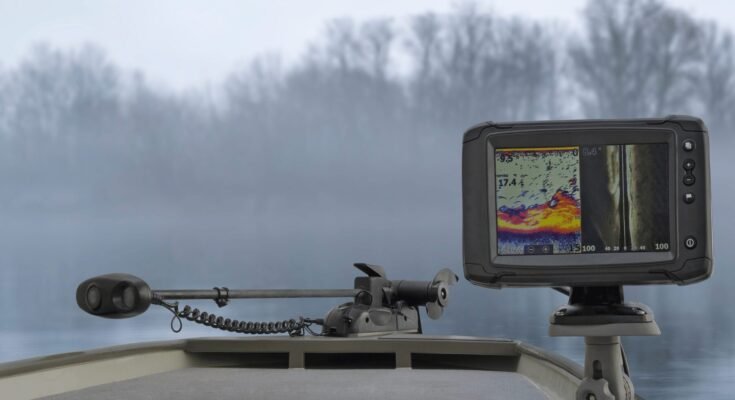
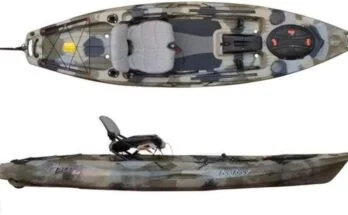
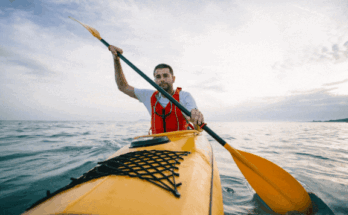
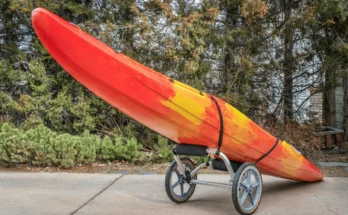
I really appreciate the depth of information you’ve provided here. It’s clear that you’ve put a lot of thought and effort into this post.
This post is exactly what I was looking for. You’ve addressed all the questions I had and provided clear, actionable advice.